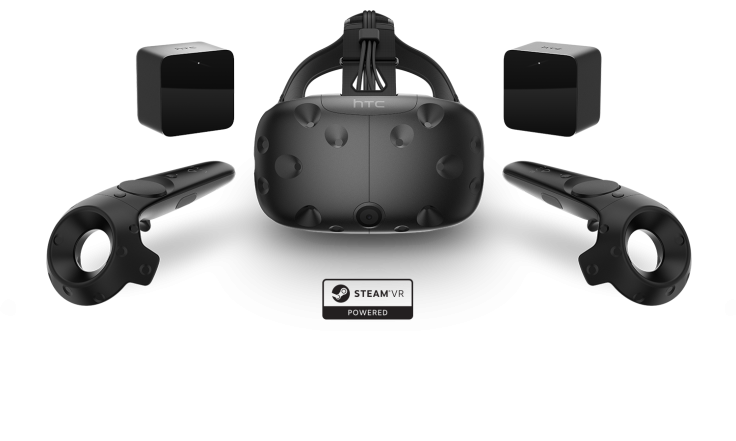The HTC Vive is unmatched among its VR competitors, says the countless reviews trickling in for the headset. They aren't wrong; the Vive is ridiculously immersive and is likely the most complete VR experience users will get in 2016. Nevermind that most in-game worlds are pretty much a collection of caricatures, which make you feel as if you are in the strangest dream of your life. Before you can get to all that, you have to set it up first.
You'd think for the $800 complete experience HTC touts, there would be a fleet of well-versed technicians available for the many early adopters that will receive their headsets in the coming days and weeks.

Editor's Note: This is a setup guide not our official Vive review, which remains a work in progress. We will update this story once it goes live.
In reality, the Vive comes with one large sheet of “Get Started” instructions, a small booklet detailing how to set up the base stations, and an on-screen set up tutorial to follow once you’ve installed the accompanying Vive computer software.
You will quickly realize setting up the Vive is a little more intricate than the plug-and-play experience HTC would have you believe.
The on-screen tutorial says it takes approximately 28 minutes to complete setup of the HTC Vive. Laugh at this. Then clear your schedule, because once you’re finished, you’re likely not going to want to see another living soul for the rest of the day.
But having spent several hours setting up the Vive in the iDigitalTimes New York office, we’ve got a nice collection of tips that should help new Vive owners get through set up a lot faster.
Here’s a rundown of things to consider when setting up your HTC Vive headset.
You don't have to mount the base stations to a wall
You can breathe a sigh of relief if you were concerned setting up the HTC Vive could cost you your security deposit. The base stations include screws and mounts for attaching the components to a wall, but this is not necessary. All you need is a high perch on which to place the base stations. The base stations need to be on opposite sides of the room and should be facing one another with no obstructions. The base stations include attachments, which can be screwed onto the base or bottom of the components and will help users properly angle them for proper communication.
Have tools handy
If you do decide to mount the base stations to a wall, you will require tools, a Phillips head screwdriver and a power drill to be exact. Don’t forget them.
Have a Displayport to HDMI adapter available if needed
Check your computer for available ports before you begin set up. If you have more Displayports than HDMI ports on your computer, you may need a Displayport to HDMI adapter to connect the Vive to your PC. We ran into this issue, having only one HDMI port and three Displayports on our computer. We used the Displayport to HDMI adapter to connect our monitor (which previously used the HDMI port) and connected the Vive directly to the computer via HDMI.
Make sure you have enough space on your hard drive
The HTC Vive typically requires a high-spec gaming computer. This doesn’t mean your computer will have the space available for the Vive VR software and games. Surely, as the hardcore gamer HTC expects you to be, your hard drive is likely already filled with games. It’s a good idea to take a glance at your hard drive capacity before installing Vive software and make room for said software if it's required. The setup software is only 60MB, but keep in mind, this is only the beginning of your VR experience.
Have a power strip and/or extension cord
In addition to having your computer hardware plugged in, you will also need power for the Vive base stations for the controllers and the link box. It will be a great benefit to have a dedicated power strip on hand. You may need an extension cord for at least one of the base stations if your placement does not have direct access to a power plug.
Have a measuring tape handy
Certainly you thought this was a VR gaming experience and not home improvement. So did we. Amid the Vive computer setup, you will have to calibrate the headset with a main wall as well as with the floor. To calibrate the headset to the floor you will need to place the Vive on a flat surface and measure the distance between and surface and the floor. Your best bet to do this quickly and successfully is by having a measuring tape on hand.
You don't need exact measurements for the floor calibration
Not having a measuring tape handy, we downloaded a ruler app and made the most rudimentary of educated guesses on the distance between the Vive’s flat surface and the floor. Fortunately, the Vive set up accepted this. So if you want or need to get creative with your measuring technique, you can.
Seriously, make sure there is nothing in the way of your play space
The instructions will tell you to make sure your play space is unobstructed. This is vital information to follow. Be sure there are no ottomans, random chairs or oddly shaped island desks in the middle of your play space as these will become obstacles once you are wearing the headset. The Vive set-up does let you trace out a play space, and will insert a visible grid into VR to let you know where the edges are. This is NOT the same thing as detecting objects, so once immersed in a Vive game you won’t be aware of the rogue desk chair and run the risk of tripping and hurting yourself, or worse, breaking your $800 VR headset.
Audio setup isn’t just plug and play
The HTC Vive comes with an intimidatingly long audio extension, and a mysterious audio jack on the headset itself. No manner of random jack swapping will net you consistent audio in your Vive experience until you set the HTC Vive as your default audio device. It’s easy to do and, once you do it, you can plug any headphones into the audio jack on the Vive headset except ...
Don't use included earbuds
Step one: Take the earbuds included with HTC Vive out of the box. Step two: Throw the earbuds included with HTC Vive directly onto the garbage. Or save them for those random audio emergencies when one side of your headphones suddenly dies. There is a high chance you won’t be using these earbuds with the HTC Vive because they are not good Seriously HTC? An $800 Vive comes with earbuds that looks like they were given out for free on a plane?
Charge controllers before you really start playing
The HTC Vive controls should have a little bit of juice out of the box. But if you go from set up straight into playing games, they will quickly begin to die and spazz out in the middle of gameplay. Charge up the controllers before or during setup so they are fully ready for use once you’ve navigated putting together the HTC Vive; or charge them up once you’ve finished setting up the Vive. You may need that time to pour yourself a drink or two anyway. Once fully charged the controllers should be functional for several hours.
The iDigitalTimes HTC Vive experience is just beginning! Make sure to check back with us throughout the week for hands-on impressions, game reviews, troubleshooting and more as we continue to review the HTC Vive.
















